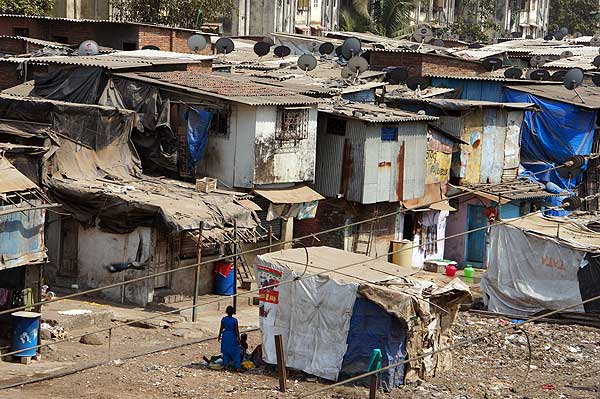
You saw Slumdog Millionaire, right? It was filmed in Dharavi, one of the world’s largest, densest slums. Bob and I spent half a day in this Mumbai slum, walking around with a couple of residents, Tauseef and Shanu, who showed off selected areas of the slum with a certain pride.
Anyone who’s visited Mumbai has driven past the slums. Awestruck and saddened by the unspeakable destitution, the flimsiness of building materials used, the population density, the proximity to lavish wealth, the naked children running in traffic, the sheer vastness, the visitor stares, horrified. Now that Mumbai’s airport has successfully banished them, the beggars come into view later; they are where the tourists go. Beautiful, tiny women with delicate features, red bindi, and elegant saris, they carry their infants and ask for money for milk powder. Or they are small, adorable children, half naked. Or maimed men. Strong impressions, for sure.
Dharavi—the biggest Mumbai slum
These images of the Mumbai slum are so renowned, and so off-putting to some, that many people say flatly “That’s one place I don’t want to visit. I don’t want to see the poverty.” Those ostriches will miss extraordinary and unforgettable scenes of lives lived in the open, from the gut-wrenching to the joyous, the heart-rending to the beautiful, the stereotypical to the eye-opening.
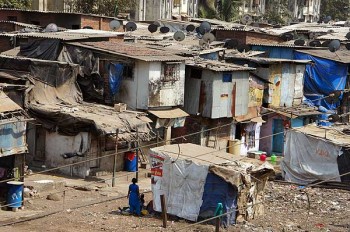
In Dharavi, one million people live in about a square mile. Bob and I were accompanied by two college student residents who were born and raised there. They led us through narrow, muddy alleys humming with activity, where we had to watch our footing, dodge men, women, and children with gigantic loads on their heads, avoid refrigerator-sized sacks of stuff lined against walls, mud puddles, and barely-covered holes in the ground.
The biggest business in Dharavi is trash recycling, exactly as in the book I’m reading, Behind the Beautiful Forevers. The trash that is sorted is not what we Westerners know as recyclables; value is found in the smallest, most insignificant things, which are heaped into piles in small, dark, brick rooms and in sacks and stacks in the alleyways. I saw four men sitting in the dirt untangling a nest of wires, the copper and aluminum from which would be stripped out. Oil drums were being scraped clean, their painted linings burned out. Cardboard was cut into new boxes; plastic cleaned, ground, melted, extruded into spaghetti and chopped into pellets; electronics taken apart; toys reconstructed; and bottles, bottles, bottles…
We visited a bakery, where a hundred infant-sized lumps of yellow dough were lined up to rise on the floor. A boy cradled them against his stomach one by one, carrying them to a shelf where men rolled them into thin sheets, folded, rerolled, and folded; then they were sliced, baked into crispness, and packaged. I ate one there, to the delight of the workers: a “puff,” they call it, a delicious flaky pastry. Yes, there were flies everywhere. Yes, men walked across the floor the dough rose upon. Yes, the boy’s undershirt was sweaty. No, I did not get sick.
A one-room batik factory was most fascinating. Fabric was laid on mounds of perfectly-smooth packed sand where men stood like machines, dipping a wooden block in hot wax then stamping it precisely in position to make a continuous pattern, swiveling, dipping, stamping. The fabric is dyed three times for ultimate brilliance.
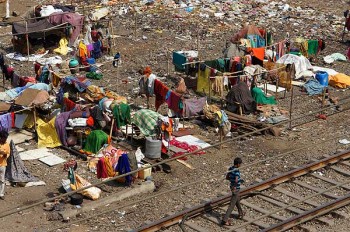
We entered unlit workshops (sweatshops?) where men and women barely looked up from their jobs except to return our greetings: a black-soap mill; a pottery shop; a wood-carvery; a room with long rows of computerized embroidery machines. We climbed a rickety ladder to see silk chiffon stretched on giant wooden frames being hand embroidered with sequins. Up another crude ladder and we were on the roof: dusty, gray corrugated metal as far as the eye could see. We saw leather tanneries and proudly-displayed belts, wallets, and purses, all plastic-wrapped for export. Who knew such incredible industry occurred inside a Mumbai slum? Dharavi is an economic hub with a billion-dollar annual production.
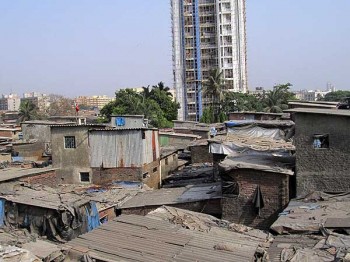
The wide, litter-strewn main street was itself a thriving market lined with vegetable, spice, and legume sellers, cooked food stalls, barbers, delivery trucks and carts, motorcycles, and people on cellphones. We peeked into a cinema—men allowed only—with no chairs, where tickets cost 20 rupees, forty US cents.
Our sense was of continuous productivity, ingenuity, and ability to squeeze a tiny profit out of almost nothing. The mood was somber. We didn’t get the spontaneous greetings we received everywhere outside of the slum. Rarely did someone in Dharavi volunteer a hello or even a smile, but they never hesitated to return ours. We did not sense hostility, and certainly not danger. We noticed a few children working, but most were supposed to be in school, of which Dharavi has many. We heard very little music, but saw a few TVs on, and there were many satellites on the roofs. We were told that as well as TVs, some residents even have washing machines.
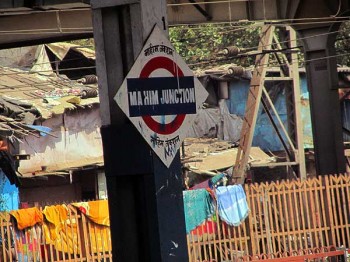
Though that was hard to believe, based on the residential area we walked through. Between buildings were mazes of narrow tunnels—not more than shoulder-width—with low ceilings, dangling wires, and wet ground made of rows of cement manhole covers. The tunnels were pitch dark and seemed to go in every direction. We got glimpses into tiny rooms which spilled a little light into the tunnels, smelled cooking here and there, heard children playing and wailing, adults talking, and the occasional TV. There were steep ladders leading to upper levels. It was otherworldly.
We came out of the dark and into a litter-filled schoolyard, where small kids played on the edge of the Mithi river, basically a cement-lined sluggish stream of sewage. Bob stood over some kids playing with a marble or something—they didn’t even look up at him. The men’s and women’s public toilets were there. Free for residents, who are expected to keep them spotless.
Bob and I had other obligations in Mumbai and had to leave Dharavi before we’d seen enough. I’m sure that in such a huge community there are celebrations, musical gatherings, sports competitions, and scenes of simple happiness. Although we didn’t get to see these, I have no doubt that they exist, despite the hard work and poor conditions that are so obvious.
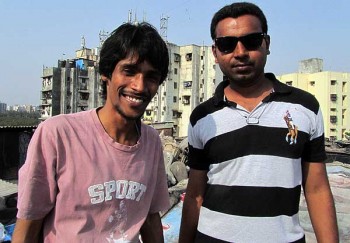
Except for our rooftop vantage point, we were discouraged from taking photos “to protect the residents.” Imagine the images I could have posted! Instead, I can only encourage you to visit Dharavi yourselves. Tauseef is co-owner of another Mumbai slum industry: Be The Local Tours & Travel. Owned and run by college students, the company’s mission statement is “With the help of students of Dharavi Be The Local is trying to dispel the negative image of Dharavi. By participating in the tour with Be The Local, you are helping the students of Dharavi.”
I’ve written here about the Mumbai slum called Dharavi, where the city’s poorest live. Many residents are migrants from India’s rural villages, seeking employment. This is by no means a story of Mumbai; just a subset of it, albeit a large one. More on Mumbai to come.






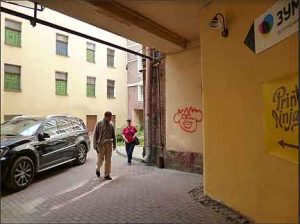
7 Comments
What made you visit Dharavi on your first day in Mumbai, Syd? Was it inspired by Slumdog Millionaire? Amazing experience, wasn’t it!
Hey, good to know you visited Dharavi. When I went to India in the summer of ’11, Dharavi is where I headed to on my first day, albeit without a guide.
I had tea with a very interesting man and we shared deep philosophy, and then I met a group of kids who actually bought me a bottle of water and hung out for a while.
I didn’t get to experience the shops and businesses like you guys did. But, I did walk from one end to the other, even through some very narrow and dark alleys at times…
I have to admit, that because it was my first day in India, and my first time alone in another country, I was very wary and did not stop walking. I even walked across a busy road and was literally forced to stand on my toes, to fit between two trucks because I was being physically squished between them in the middle of the road. That’s how badly I didn’t want to stop walking.
At first I wore my hood that was attached to my shirt with my baseball cap on top of it to try to avoid drawing extra attention… The old man whom I had tea with stated that doing that just brings negative attention to me, because it’s not very friendly. Like I said, I was very nervous, but extremely curious, interested, and open-minded about the whole thing.
I found that while walking around Dharavi, if I managed to do the Indian Head bobble, smile, and say aacha to anyone staring at me, they’d smile or burst out laughing, and return the head bobble and aacha back at me.
It was a good experience and I’m happy I went. 🙂
[…] these Mumbai stories of trains, crowds, swamis, the slum called Dharavi, and promises of more stories… What you’re really wondering is: did the Thiefhunters find […]
[…] Post navigation ← Previous […]
[…] Post navigation ← Previous Next → […]
I did enjoy Shantaram, but even more, the 2004 non-fiction Maximum Bombay, by Suketu Mehta. Thanks for the bd wish—appreciated! But see “A Better Way to Celebrate Birthdays: http://bobarno.com/thiefhunters/2008/05/better-way-to-celebrate-birthdays/
Hey B. I think you’d probably enjoy large parts of Shantaram (book).
Happy birthday in advance for Saturday 🙂
T